Topics: |
Topics: |
An active report is a report that is designed for offline analysis. When using an active report, you can:
- Interact with the data, using analysis options similar to those found in an Excel® workbook, without any connection to a server. Analysis options include filtering, sorting, charting, and much more.
- Work offline without any additional plug-ins or programs. An active report is a self-contained report, meaning that it contains all the data and JavaScript® within the HTML output file. Packaging the data and the interactive functions in the HTML file also makes the output highly compressible for email and transparent to security systems.
- Save the report on
a local machine with active report functionality. Since no connection
to a server is required to view the data or use the analysis options,
you can save and use the report anywhere.
Performance may vary across browsers due to browser-specific memory limitations. For very large reports, Internet Explorer® may produce an error. For more information, refer to the Microsoft® website.
When working with an active report, you can:
- Filter or highlight data.
- Sort data within any column in ascending or descending order.
- Apply calculations to columns and choose the location at which to display results.
- Control the display of data by hiding columns, freezing columns, limiting the number of rows per page, and using graphic visualization to compare column values.
- Create a variety of simple or advanced charts (pie, line, bar, or scatter) and Rollup Tables.
- Apply a global filter to multiple reports within the same HTML page.
- Export report data and chart data.
- Restore original report settings.
- Run active reports on your mobile device with the Opera™ browser (Version 8.60 U2 or higher) installed. See the Opera website for a list of supported devices.
The following image shows an HTML active report. The pop-up menu is open for the Sale Unit(s) column, with the Calculate Avg operator selected.
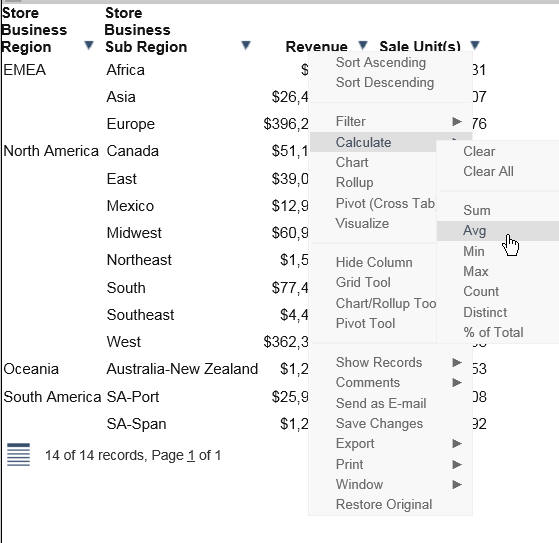
The following image shows the options that are available at the cell level for a report in active report format. Included are the options that reflect Auto Drill, Multi Drill, and Auto Linking functionality. For more information, see Customizing Content.
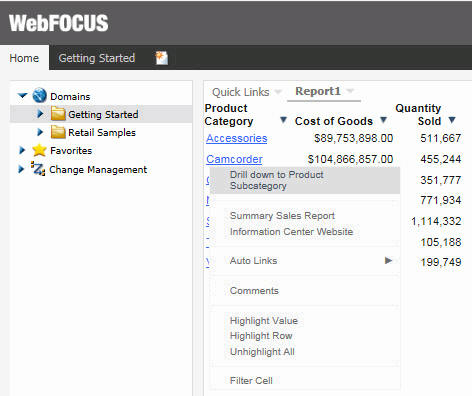
You can password protect an active report. This feature restricts users from viewing the report by requiring them to enter a password before opening the report. The data is encrypted using the 256-bit Advanced Encryption Standard (AES) specification. The password is used as the key for decrypting and encrypting the data. Therefore, the password is not stored in the report, and you do not need a connection to go back to the server for password verification.
The HTML page that you receive contains both the JavaScript and the data for the report so that you can interact with the data in a disconnected mode. Internet Explorer detects the JavaScript and issues a warning. If you look at the Internet Explorer warning, it mentions explicitly the detection of active content, which is the JavaScript. The same warning appears when pop-ups are blocked in the browser.
Because all post-retrieval processing is performed in the memory of the web browser, an active report has a processing limit of approximately 5,000 records or 100 pages of output. The active cache option enables you to send only the first page of active report output to the browser and retrieve subsequent pages from a temporary cache on the WebFOCUS Reporting Server. The server also becomes the resource for performing all calculations, sorting, and filtering when active cache is enabled. Since active cache uses on-demand paging functionality, WebFOCUS Viewer is not supported.
The active report with active cache option in the clustered server environment, using Cluster Manager (CLM), will maintain the connection with the WebFOCUS Reporting Server on which the temporary cache is created. This enables the retrieval of subsequent pages from the browser, while the report is in the same browser session.
The active cache feature uses a POST instead of a GET in an HTTP request.
Topics:
How to: |
An active report is a self-contained report that is designed for offline analysis.
- Create a report.
- From the Output Types menu, located at the lower-right of the window, click active report.
- Drag fields onto the canvas or into the Query pane to build your report.
-
Run the
report.
Menu options for an active report are described in the following table.
|
Option |
Definition |
|---|---|
|
Sort Ascending |
Sorts the column in ascending order. |
|
Sort Descending |
Sorts the column in descending order. |
|
Filter |
Filters the data. Options are:
|
|
Calculate |
Calculation types that you can apply to the column:
For numeric fields, you can also apply:
|
|
Chart |
Creates an active chart from the report. Options are Pie, Line, Column, and Scatter. |
|
Rollup |
Lists the fields available to create a Rollup table. |
|
Pivot (Cross Tab) |
Lists the fields available to create a Pivot table. |
|
Visualize |
Adds visualization bars to, or removes them from, the selected column. The Visualize option is available for numeric data columns. |
|
Hide Column |
Suppresses the display of the selected column in the report. |
|
Show Columns |
Lists the names of the columns that are hidden in the report, allowing you to individually restore a column. Select the name of a specific column in the hidden columns list to restore that column to the report. |
|
Freeze Column |
Freezes the report at a particular point so that columns to the left of the freeze point remain in view while the user scrolls through the other report columns. Note: If the report can be fully viewed in the browser window, freeze is not applied. The Freeze column option is not available for expandable report (Accordion) views. |
|
Unfreeze All |
Unfreezes the columns. |
|
Grid Tool |
Opens the Grid Tool, which you can use to change the column order, select multiple columns to sort ascending or descending, hide and show columns, add a calculation result to a column, and add subtotals to the active report. |
|
Chart/Rollup Tool |
Opens the Chart/Rollup Tool, which you can use to select multiple group fields to generate the chart or rollup table. The Chart/Rollup Tool contains a list of columns available in the active report to add to Group By and Measure fields. Drag the columns into the field that you want. |
|
Pivot Tool |
Opens the Pivot Tool, which you can use to select multiple group fields to generate the chart or pivot table. The Pivot Tool contains a list of columns available in the active report to add to Group By, Across, and Measure fields. Drag the columns into the field that you want. |
|
Show Records |
Opens the Show Records menu option to list the number of records available for display per page in the report. Select a number (for example, 10) to display, per page. Default displays the number of records (lines) per page that is specified in the WebFOCUS report procedure. |
|
Comments |
Options to display comments under cells or hide indicators for comments in the active report output. |
|
Send as E-mail |
Enables you to save and send the report as email. Note: To use this feature, you must have ActiveX enabled in your browser security settings. This feature is only supported in Internet Explorer. |
|
Save Changes |
Saves changes. Note: To use this feature, you must have ActiveX enabled in your browser security settings. This feature is only supported in Internet Explorer. |
|
Export |
When active cache is enabled, exports all records or filtered only records to HTML, CSV, Excel, or PDF. Note: active cache is enabled on an active report when you click Pages On Demand on the Format tab, in the Navigation group. When active cache is disabled, exports all records or filtered only records to HTML, CSV, or XML (Excel). To use this feature, you must enable ActiveX in your browser security settings. |
|
|
Prints all records or filtered only records. |
|
Window |
Displays reports in a cascade or separate tabs. |
|
Restore Original |
Restores the active report to the default state specified in the report procedure. |
When you are working in active report format, the following data cell options display.
|
Option |
Definition |
|---|---|
|
Drill down |
Enables you to drill down one level in the hierarchy of your data source. This option displays for reports that have Auto Drill enabled. |
|
Drill up |
Enables you to drill up one level in the hierarchy of your data source. This option displays for reports that have Auto Drill enabled. |
|
Restore Original |
Restores the active report to the default state specified in the report procedure. |
|
Auto Links |
Displays a list of target reports that are linked to the Auto Link enabled report. This option displays for reports that have Auto Linking enabled. |
|
Comments |
Enables you to add comments about data in your report. The result is an annotation that displays when you hover over it run time. |
|
Highlight Value |
Enables you to highlight a particular value in your report. |
|
Highlight Row |
Applies highlighting to the selected row in your report. |
|
Unhighlight All |
Removes any applied highlighting from values or rows in your report. |
|
Filter Cell |
Enables you to filter the output, showing only a selected row of data. |
|
Remove Cell Filter |
Removes any applied cell filters. |
You can configure active report options, including menu options, based on user role, through the active report options dialog box.
You can access the dialog box on the Format tab, in the Features group, by clicking the active report options button. The button is available when active report is selected as the output type.
The active report options dialog box contains the following tabs:
- General
- Menu Options
- Colors
- Advanced
Use the General tab to set common properties specific to active reports.
The General tab contains the following options:
Display. This area contains options to set the window to cascade or tabs, and options to freeze columns.
- Window. Select the window setting. The options are Cascade and Tabs.
- Freeze Columns. Select the columns you would like to freeze. You can also select None.
Page Options. This area contains options to set the number of records per page, enable the display of page information, edit the alignment, and set the location of the page information.
- Records Per Page. Select or type the number of records that you would like to display per page. The default value is 57.
- Display Page Information. Select this option to display page navigation information. Clear this option to disable the display of page navigation information.
- Alignment. Click the appropriate button to set the alignment of the page navigation information. Options are Left, Center, and Right.
- Location. Select the location for the page navigation information. The options are Top Row and Bottom Row.
Chart Options. This area contains options that pertain to charts.
-
Chart Engine. The
chart engine determines the set of charts that you can create. The
option is:
- HTML5. Uses the new JavaScript charts for the output format type AHTML. These charts work in both connected and disconnected mode. The current AHTML default four JavaScript charts will not be available at run time.
Use the Menu Options tab to select a user type and which options to display in the menu.
The Menu Options tab contains the following options:
-
User Type. The
options are Power, Analyst, Basic, and Custom.
- Power. This is the default user type. It enables all functionality.
- Analyst. This user type has the following functionality: Show Records, Freeze, Hide/Unhide, Export, Sorting, Pivot, Filter, Calculations, Chart, Visualize, Restore Original, Save Changes, and Accordion.
- Basic. This user type has the following functionality: Show Records, Freeze, Hide/Unhide, Sorting, Filter, Calculations, Visualize, and Restore Original.
- Custom. If you select a combination of options that does not match one of the existing user types (Power, Analyst, Basic), the User level name that appears in the User Type field is Custom. This is not a default user type or a selectable user type. It indicates that options for this user do not match any of the existing user types.
The options available according to user type include the following:
- Show Records. Shows all records or specific numbers of records.
- Freeze. Freezes and unfreezes columns.
- Hide/Unhide. Hides and shows columns.
- Export. Exports data to HTML, CSV, Excel, or PDF (active cache is enabled); or to HTML, CSV, or XML (Excel) (active cache is disabled).
- Sorting. Sorts data in ascending or descending order.
- Pivot. Lists the fields available to create a Pivot table.
- Window Type. Shows windows as cascade or tabs.
- Send as Email. Enables you to send a report as email.
- Print. Prints all records or filtered-only records.
- Advanced Tools. Accesses the Chart/Rollup, Pivot, and Grid Tools.
- Filter. Opens the Filter Selection dialog box.
- Calculations. Performs the following calculations: Sum, Avg, Min, Max, Count, Distinct, % of Total.
- Chart. Converts a report to a pie, line, bar, or scatter chart.
- Visualize. Adds data visualization bars to a report.
- Rollup. Performs rollup on data.
- Comments. Adds comments.
- Restore Original. Restores the active report to the default state specified in the report procedure.
- Save Changes. Saves changes.
- Accordion. Produces accordion reports.
- Grid Tool. Opens the Grid Tool dialog box.
Use the Colors tab to select colors for various objects on the report.
The Colors tab contains the following options:
Page. This area contains options to set the colors for the font and background of the page text.
- Font. Opens the Color dialog box, where you can select the font color.
- Background. Opens the Color dialog box, where you can select the background color for the page text.
Row Selection. This area contains options to set the colors that appear when you point to or select a row on the report.
- Hover. Opens the Color dialog box, where you can select the color that the row becomes when you hold the mouse over the row.
- Selected. Opens the Color dialog box, where you can select the highlight color that the row becomes when you use the highlight option.
Visual. This area contains options to set the colors for the data visualization bars.
- Positive. Opens the Color dialog box, where you can select the color for a data visualization bar that represents a positive number.
- Negative. Opens the Color dialog box, where you can select the color for a data visualization bar that represents a negative number.
Calculations. This area contains options to set the colors for values in a calculation.
- Font. Opens the Color dialog box, where you can select the font color for the calculation.
- Background. Opens the Color dialog box, where you can select the background color for the calculation.
Menu. This area contains options to change the color of the menu.
-
Normal
- Font. Opens the Color dialog box, where you can select the color for the text of the options on the column menus.
- Background. Opens the Color dialog box, where you can select the background color for the column menus.
- Border. Opens the Color dialog box, where you can select the color for the border of the column menus.
-
Hover
- Font. Opens the Color dialog box, where you can select the color for the text of the options on the column menus when you point to them.
- Background. Opens the Color dialog box, where you can select the background color that appears behind options on the column menus when you point to them.
Use the Advanced tab to control the number of rows retrieved from active cache and to add security settings.
Note: active cache is enabled when you select active report as the output type, and click Pages On Demand on the Format tab, in the Navigation group.
The Advanced tab contains the following options:
active cache. Enables a report to cache the data in a binary file and return the data to the output window in pre-set increments.
- Rows Retrieved. Select the number of rows retrieved in the output. The default value is 100.
Security. This area allows you to set a password to access the report and enable expiration by date or by days.
Note: When setting security options for active reports, be aware that security options can be set for each individual component on the canvas, but only one password can be set for the entire document.
Topics: How to: |
An active chart is a chart that is designed for offline analysis. For more information, see Active Technologies Report Overview.
- Create a chart.
- On the status bar, in the Output Types menu, click active report.
-
Generate
the chart.
The following image shows an HTML5 pie chart that displays the sum of the values in the Quantity Sold field by Product Category.
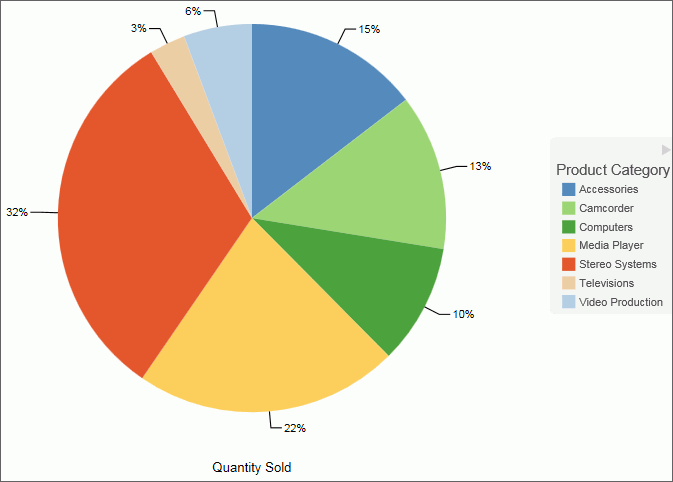
Options for an active chart are described in the following table.
|
Option |
Definition |
|---|---|
|
New |
Creates a new chart. Options include:
|
|
Column |
Displays data as a column chart. |
|
Pie |
Displays data as a pie chart. |
|
Line |
Displays data as a line chart. |
|
Scatter |
Displays data as a scatter chart. |
|
Advanced Chart |
Opens the Chart/Rollup Tool. |
|
Original Chart |
Restores the active chart to the chart type specified in the report procedure. |
|
Sum |
Applies the following options to a Measure field: Sum, Avg, Min, Max, Count, and Distinct. |
Topics: How to: |
To create an active dashboard, use Document mode in active report output format.
You can create an active dashboard by inserting active dashboard prompts into a document to act as filters for the reports on the dashboard. You can also cascade (chain) prompts to populate them based on the selections from the previous prompts. The output format of the active dashboard must be active report in order to add active dashboard prompts.
The Active Dashboard Prompts group contains buttons that insert active dashboard prompts into your dashboard. This group is only visible when the output format of the dashboard is set to active report. You can access the active dashboard prompts on the Insert tab, in the active dashboard prompts group.
The following are the types of active dashboard prompts that you can use to apply filters to an active dashboard:
- Drop Down. Inserts a drop down prompt placeholder in the upper-left corner of the canvas.
- List. Inserts a list prompt placeholder in the upper-left corner of the canvas.
- Checkbox. Inserts a check box prompt placeholder in the upper-left corner of the canvas.
- Radio Button. Inserts a radio button prompt placeholder in the upper-left corner of the canvas.
- Text. Inserts a text area prompt placeholder in the upper-left corner of the canvas.
Note: The display of values populated in active dashboard prompts is dependent on the data setting. For example, if sample data is turned on, then active dashboard prompts will show sample data, such as:
WF_RETAIL1 WF_RETAIL2 WF_RETAIL3
When you bind a field to an active dashboard prompt, the default target report is the report from which you dragged the field. You can add or remove target reports from an active dashboard prompt through the active dashboard properties dialog box. For more information on using the active dashboard properties dialog box, see Using Multiple Reports as Targets and Sources.
A report must meet one of the following requirements to be a target report:
- The report must contain a field with the same name as the source field (actual field name or AS name).
- The Master File of the report must contain a field with the same name as the source field.
If a report is eligible to be a target report because the field has the same user-supplied title and the title is changed, the report is automatically removed as a target.
This procedure describes how to begin to create a dashboard by creating one report and binding a single prompt to one of the fields of the report.
- Create an active dashboard in Document mode.
- From the Output Types menu, located at the lower-right of the window, select the active output type (active report).
-
On the Insert
tab, in the Reports group, click Report.
A placeholder appears on the canvas.
- Drag fields onto the canvas, or into the Query pane, to create the report and start building the dashboard.
-
On the Insert
tab, in the active dashboard prompts group, select a dashboard prompt
to insert into the document.
An active dashboard prompt appears in the upper-left corner of the canvas. If the report is located in the upper-left corner of the canvas, you will have to drag the prompt off the report.
-
Select the report and bind one of its
data source fields to the prompt in one of the following ways:
- Query pane: Select the report. From the Query pane, drag the field that you want to bind onto the prompt.
- Report on the canvas: Click the report on the canvas. You can now edit it. Highlight the column that contains the data that you want and drag it onto the prompt.
Once you have bound the field to the prompt, the values of the field appear in the prompt.
Note: Once an active dashboard prompt is added to the canvas, the document is locked in an active output format. You cannot change the active report format if there are prompts present on the canvas. To switch to a non-active output format, you must remove all prompts.
You can add multiple reports and charts to an active dashboard. Each report can have multiple prompts associated with it.
The following procedure describes how to set up active dashboard prompts for two reports on a dashboard. In the example that is used, the first report contains information about the categories of electronics products sold in various regions. The Region field will be bound to a group of radio buttons. Each radio button will represent a particular region in which the electronics are sold. When you select a radio button for a region, for example, NorthEast, the report will be filtered by your selection.
The second report contains information about the gender and age group of electronics consumers. The Gender field will be bound to a drop-down list. The list will display the values, male and female. When you select a gender from the drop-down list, the report will be filtered by your selection.
-
Create an
active dashboard in Document mode, or open an existing dashboard
containing two or more reports, and add two active dashboard prompts,
as described in How to Add an Active Technologies Dashboard Prompt to a Dashboard.
-
Right-click
the active dashboard prompt you want to bind a field to and click Properties.
The active dashboard properties dialog box opens.
The Prompts list displays the two prompts (combobox_1 and combobox_2) that were added to the dashboard in step 1. The prompt titled combobox_2 is highlighted because it was selected in step 2.
-
From the
Report drop-down menu, select the report that contains the field
you want to bind an active dashboard prompt to.
In this example, the radio button list (list_1) has been selected as the prompt for the region report (Report1), as shown in the following image.
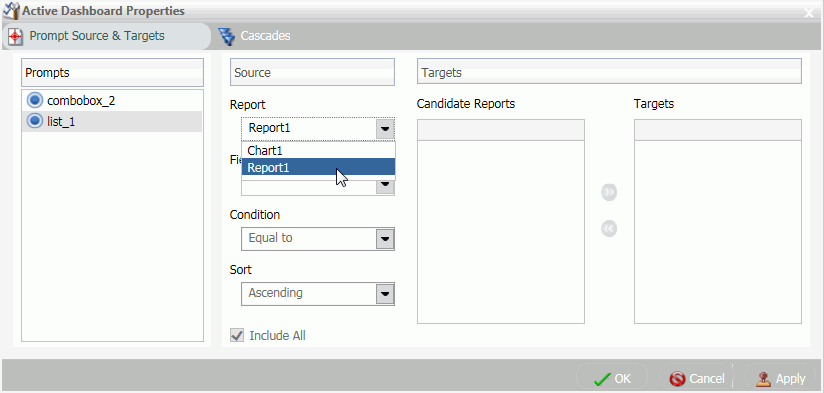
The next step describes how to bind the Region field from the region report to the radio buttons list to filter that report.
-
From the
Field drop-down menu, select the field to which you want to bind
the active dashboard prompt.
In this example, the Product,Category field has been selected for the radio buttons list (list_1), as shown in the following image.
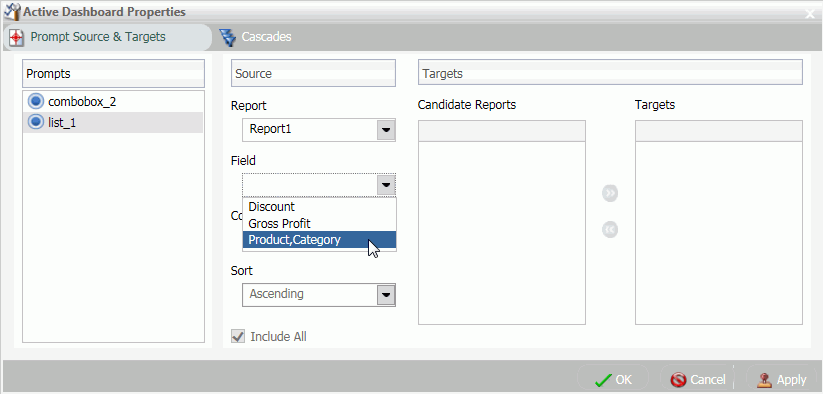
Note: You can optionally specify an ascending or descending sort order for the current scenario.
-
Click OK.
The prompt is now bound to the field on the dashboard.
In the following image, the radio buttons list is bound to the Product,Category field. It displays all product categories by which a user can filter the report.
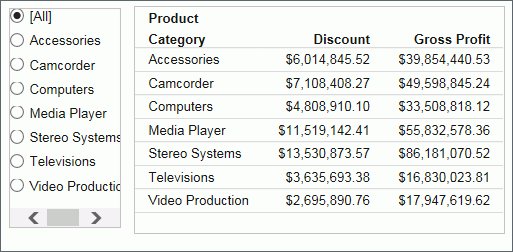
The following steps describe how to bind the Gender field in the gender report (Report2) to the drop-down list prompt.
-
Right-click
the next active dashboard prompt to which you want to bind a field
and click Properties.
The active dashboard properties dialog box opens again.
Notice that combobox_2, the prompt selected on the dashboard, is selected in the Prompts list.
-
From the
Report drop-down menu, select the report that contains the field
you want to bind an active dashboard prompt to.
The next step describes how to bind the Gender field from the gender report to the drop-down list to filter that report.
-
From the
Field drop-down menu, select the field to which you want to bind
the active dashboard prompt.
Once the Gender field has been selected, Report2 (gender report) appears in the Target list and Report1 (region report) appears in the Candidate Reports list.
Note: To move a report from the Candidate Reports list box to the Targets list box, select it and click the Add to List arrow. To remove a report from the Targets list box, select it and click the Remove from List arrow. You can select multiple reports by holding down the Ctrl key and clicking each one.
-
Click OK.
The prompt is now bound to the field on the dashboard.
In this example, the drop-down list is bound to the Gender field. A user could filter the gender report by male or female.
You can change the field to which the active prompt is bound.
- Create an active dashboard in Document mode, or open an existing dashboard, and bind an active prompt to a field.
-
Right-click
the active dashboard prompt that you want to configure, and click Properties.
The active dashboard properties dialog box opens.
-
From the
Field menu, select a different field.
A warning message alerts you that changing the source field for the prompt will remove the existing prompt and any dependent (child) prompts from the cascades.
- Click OK to close the warning.
-
Click OK to
close the active dashboard properties dialog box.
The active dashboard prompt is updated with the new source field.
- Create an active dashboard in Document mode, or open an existing dashboard, and bind an active dashboard prompt to a field, as described in How to Add an Active Technologies Dashboard Prompt to a Dashboard.
-
Right-click
the active dashboard prompt that you want to work with, and from
the shortcut menu, select Properties.
The active dashboard properties dialog box opens.
- From the Condition drop-down menu, select the filter condition for the active dashboard prompt. The options are Equal to, Not equal to, Less than, Less than or equal to, Greater than, and Greater than or equal to.
-
Click OK.
The filter condition is applied to the active dashboard prompt.
-
Create an
active dashboard in Document mode, or open an existing dashboard
containing at least one report, and add at least two active dashboard
prompts, as described in How to Add an Active Technologies Dashboard Prompt to a Dashboard.
-
Bind the
fields to prompts that you have added, as described in How to Add an Active Technologies Dashboard Prompt to a Dashboard.
When you have more than one prompt on the canvas, you can cascade prompts to populate them based on the selections of the previous prompts. Cascading prompts have a parent-child relationship, in which the parent filters the available options of the child.
An active prompt can be the parent of more than one other prompt, but cannot be a child of more than one prompt.
-
Create an
active dashboard in Document mode, or open an existing dashboard,
and bind at least two active prompts to fields.
-
Right-click
the active dashboard prompt that you want to configure, and click Properties.
The active dashboard properties dialog box opens.
-
Click Cascades.
By default, a cascade named Cascade1 appears in the Cascades section of the active dashboard properties dialog box.
- You can click the Create
a new cascade
 button
to create a new cascade.
button
to create a new cascade. - You can click the Delete
selected cascade
 button
to delete the selected cascade.
button
to delete the selected cascade.
- You can click the Create
a new cascade
- Select the cascade to which you want to add prompts.
- From the Available Prompts list box, select the prompt that you want to add.
-
Click the Add
to List arrow to move the selected prompt to the Selected
Prompts list box.
Note: You can remove prompts from the Selected Prompts list box by selecting them and clicking the Remove from List arrow.
-
Add any
additional prompts you want to be part of the cascade by repeating
steps 5 and 6.
By default, the hierarchy of the prompts is determined by the order in which they are added to the Selected Prompts list. The cascade of the prompts is from top to bottom. The prompts that come first in the Selected Prompts list are the parents of the lower prompts.
-
You can
change the hierarchy of the prompts by selecting a prompt in the Selected
Prompt list box and clicking the Move Up and Move Down arrows.
-
Click OK.
The cascade is created.
-
Run the
report.
Note: If you set up more than one cascade, the cascade that you interact with last is the one that filters the report.
| WebFOCUS |
Feedback |